
Gimhae International Airport (Korean: 김해국제공항) is located on the western end of Busan, South Korea. Opened in 1976, the airport is named after the nearby city of Gimhae. A new international terminal opened on October 31, 2007. Gimhae International Airport is the main hub for Air Busan, and a secondary hub for Asiana Airlines and Korean Air. Runway 18L/36R is used for military purposes only for Gimhae Air Base, but due to increasing traffic, there are plans to open the runway for airliners. In 2018, 17,064,613 passengers used the airport.

The Seoul Metropolitan Subway is a metropolitan railway system consisting of 23 rapid transit, light metro, commuter rail and people mover lines located in northwest South Korea. The system serves most of the Seoul Metropolitan Area including the Incheon metropolis and satellite cities in Gyeonggi province. Some regional lines in the network stretch out beyond the Seoul Metropolitan Area to rural areas in northern Chungnam province and western Gangwon province, that lie over 100 km (62 mi) away from the capital.
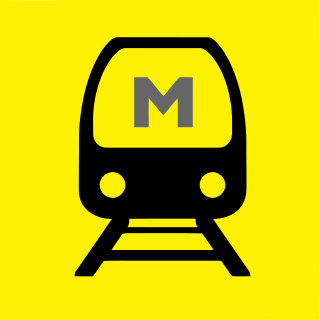
Rapid transit systems operate in six major South Korean cities, except for Sejong.

Seoul Subway Line 6 is a line of the Seoul Metropolitan Subway. The route connects Eunpyeong-gu and Jungnang-gu in a U-shaped manner, running through Yongsan-gu and Seongbuk-gu. It does not cross the Han River. It is mainly used to connect to the northern outskirts of Seoul and to relieve the traffic on other lines.

Seoul Metro Corporation was a municipal-owned corporation owned by the Seoul Metropolitan Government. Established in 1970, it was, with Seoul Metropolitan Rapid Transit Corporation and Korail, one of the major operators of Seoul Metropolitan Subway. The company merged with Seoul Metropolitan Rapid Transit Corporation in 2017.

Gwangju Airport is an airport in the city of Gwangju, South Korea and is managed by the Korea Airports Corporation. In 2018, 1,986,125 passengers used the airport. This airport is planned to close when Muan International Airport becomes more established. Because Gwangju Airport is sharing with military, taking photograph or video of apron, runway and military facility is strictly prohibited.
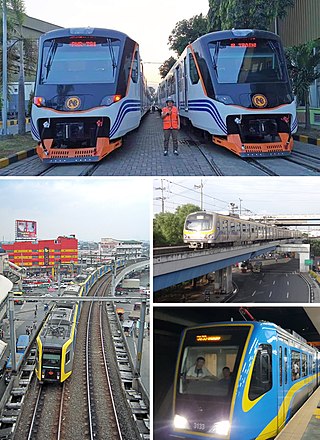
Rail transportation in the Philippines is currently used mostly to transport passengers within Metro Manila and provinces of Laguna and Quezon, as well as a commuter service in the Bicol Region. Freight transport services once operated in the country, but these services were halted. However, there are plans to restore old freight services and build new lines. From a peak of 1,100 kilometers (680 mi), the country currently has a railway footprint of 533.14 kilometers (331.28 mi), of which only 129.85 kilometers (80.69 mi) are operational as of 2024, including all the urban rail lines. World War II, natural calamities, underspending, and neglect have all contributed to the decline of the Philippine railway network. In the 2019 Global Competitiveness Report, the Philippines has the lowest efficiency score among other Asian countries in terms of efficiency of train services, receiving a score of 2.4, and ranking 86th out of 101 countries globally. The government is currently expanding the railway network up to 1,900 kilometers (1,200 mi) by 2022 through numerous projects.

Daegu Metro is a metro system that serves primarily the South Korean city of Daegu, operated by Daegu Metropolitan Transit Corporation from 5:30AM to 0:00AM with the interval from 5 to 8 minutes between each car's arrival. With the fastest track speed at 80 km/h (50 mph), it takes 55 minutes for Line 1 and Line 2, and 48 minutes for Line 3 to reach the terminus station. As of 2015, the number of average daily passengers is 186,992 people for Line 1, 177,984 people for Line 2, and 69,127 people for Line 3.

Yongin EverLine is a fully automated driverless 18.1-kilometer (11.2 mi) people mover line in Yongin, Gyeonggi Province, Seoul Capital Area connecting Everland, South Korea's most popular theme park, to the Suin-Bundang Line of the Seoul Metropolitan Subway, a system which it is arguably a part of. The system is identical to the AirTrain JFK people mover and airport rail link in New York City, using single-car Bombardier Advanced Rapid Transit vehicles controlled by Bombardier CITYFLO 650 automatic train control technology.
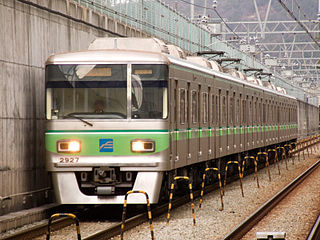
The Busan Metro is the urban rail system operated by the Busan Transportation Corporation of Busan, South Korea. The metro network first opened in 1985 with seventeen stations, making Busan the second city in South Korea and third in the Korean Peninsula to have a metro system. The Metro itself consists of 4 numbered lines, covering 116.5 kilometres (72.4 mi) of route and serving 114 stations. Including the BGL and the Donghae Line, the network covers 205.6 kilometres (127.8 mi) of route and serving 158 stations.

A medium-capacity system (MCS), also known as light rapid transit or light metro, is a rail transport system with a capacity greater than light rail, but less than typical heavy-rail rapid transit. MCS's trains are usually 1–4 cars. Most medium-capacity rail systems are automated or use light rail type vehicles.

The history of rapid transit began in London with the opening of the Metropolitan Railway, which is now part of the London Underground, in 1863. By World War I, electric underground railways were being used in Athens, Berlin, Boston, Buenos Aires, Budapest, Glasgow, Hamburg, Istanbul, Liverpool, New York City, Paris, and Philadelphia.

Daejeon Metro is the rapid transit system of Daejeon, South Korea, operated by the Daejeon Metropolitan Express Transit Corporation. The single-line subway network first opened in 2006 with 12 stations. The line was expanded in 2007 and it now consists of one line, 22 operating stations, and 22.74 kilometres (14.13 mi) of route.

Hakdong·Jeungsimsa station is a station on Line 1 of the Gwangju Metro in Hak-dong, Gwangju, South Korea. It opened on April 28, 2004.
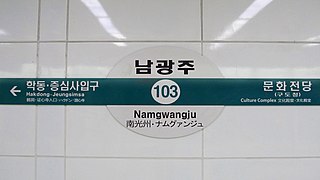
Namgwangju station is a station on Gwangju Metro Line 1, located at Hak-dong 994 in Dong-gu, Gwangju, South Korea. It opened for service on April 28, 2004.

Urban rail transit in India plays an important role in intracity transportation in the major cities which are highly populated. It consists of rapid transit, suburban rail, monorail, and tram systems. According to a report published in 2021, a total of 2.63 billion people traveled annually in metro systems across India's sixteen major cities, placing the country as one of the busiest urban rapid transit hubs in the world in terms of commuters. The combined length of 895 kilometres of metro systems in India makes it the third longest in operation in the world.
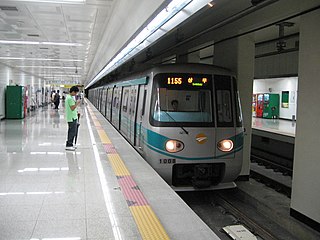
Gwangju Metro is the rapid transit system of Gwangju, South Korea, operated by the Gwangju Metropolitan Rapid Transit Corporation. The subway network first opened in 2004 with 14 stations. The Gwangju Metro consists of one line, serving 20 operational stations, and operating on 20.1 kilometres (12.5 mi) of route. It crosses both of the major rivers in Gwangju, the Yeongsan River and the Hwangryong River. Most of the system is underground, except for the sections between Sotae-Nokdong and Pyeongdong-Dosan.

Kim Daejung Convention Center station is a station of Gwangju Metro Line 1 in Mareuk-dong, Seo-gu District, Gwangju, South Korea. The Gwangju Metropolitan Rapid Transit Corporation is near the station. The station name comes from Kim Daejung Convention Center, which is nearby the station.
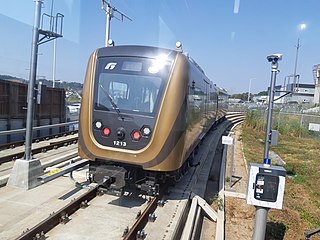
The Gimpo Goldline is a light metro line opened on 28 September 2019.

Rail transportation in the Greater Manila Area is a major part of the transportation system in Metro Manila and its surrounding areas. It consists of the Manila Light Rail Transit System, Manila Metro Rail Transit System, and the PNR Metro Commuter Line. The network makes up the majority of active railways in the country and bear the brunt of providing the metropolis with rail as a faster alternative mode of transport other than buses and jeepneys. However, these systems are currently insufficient for the rapidly expanding metropolis; to address this, new lines and line extensions are under construction, which will extend the system far out into neighboring regions.



















